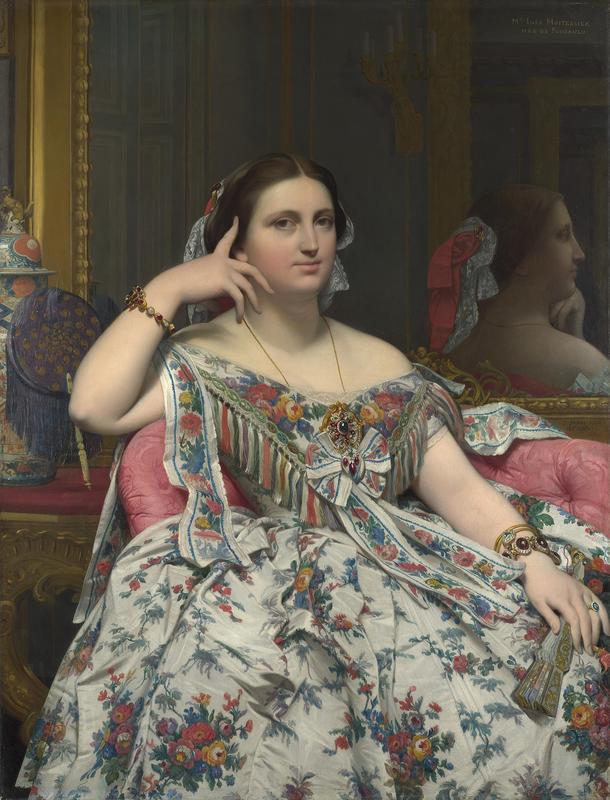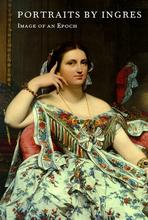More about Madame Moitessier
- All
- Info
- Shop

Sr. Contributor
Madame Moitessier, a commission done specifically for beauty and not money, was a labor of love twelve years in the making for Ingres.
When this commission came about, Ingres was riding a popularity high and intended to use it as an opportunity to move away from the days of quickly sketching aristocrats for cash. He wanted to explore big truths in his paintings, things of meaning that meditated on the human condition. So, a portrait commission was far from an appealing proposition.
In other words, if he was a film director, he wanted to focus on Oscar bait material, not fall into Hallmark movie offers. But, Ingres had a really good friend who brought him to a dinner party and introduced him to the beautiful Ines Moitessier before floating the idea of a portrait commission. Ingres agreed to it for the sake of her beauty and, as he put it, her “terrible et belle tête” (terrible and beautiful head). Ingres likened her to the goddess Juno. In fact, the pose in the portrait comes from a fresco of Juno in order to make the parallel he saw more evident.
Despite Ingres' admiration for the Madame's good looks, the portrait was slow going and went through several iterations. Originally, it was supposed to be a mother and daughter portrait, so Madame Moitessier was positioned off-center with her daughter leaning her head on her lap. By the time the portrait neared completion, the daughter was a tad too old for such a pose and the idea was nixed. Ingres actually took the canvas off the board and reset it to place Madame Moitessier in the center of the frame.
Over the next few years Ingres moved on slowly with the painting. One of the most major reasons for his long delay was tragedy striking; Ingres lost his wife and didn’t paint for roughly two years. Luckily, the Moitessier family understood his grief and didn’t push the issue. It wasn't until in year seven of the commission that Monsieur Moitessier reminded Ingres of their deal, specifically the financial aspect of the agreement. Ingres ended up making an entirely separate second portrait of Madame Moitessier, which he completed in only a few years, instead of rushing to finish the first.
Able now to work at his leisure, Ingres took his sweet time with the details, even having assistants do sketches of the interior of the Moitessier family living room. If you look closely at the bottom left corner of the mirror you’ll see a tiny Cupid blowing her a kiss, perhaps a small love letter from Ingres to his beautiful subject.
The last major adjustment was a wardrobe change. Madame Moitessier had originally been painted in a yellow gown, but dresses made of fabric with richly embroidered flowers had become the latest trend. Even though the portrait had taken twelve years thus far, Madame Moitessier wanted to make sure her likeness represented the most cutting edge of fashion.
As a final touch, Ingres decided to be extra and, wanting to echo the flowers of Madame Moitessier’s dress, he designed a special and ornate frame covered in golden flowers to house the piece. When the portrait first found its way to a museum, the museum’s director didn’t want his purchase of the piece to seem too ostentatious, so he had it swapped out for a more modest one. A couple decades later, the original frame was found in storage and the two were reunited.
As a small footnote to this tale, after Ingres passed and his estate was being handled to go to auction, his relatives came across a number of sketches he had done for this commission. They reached out to Monsieur Moitessier prior to the auction to see if he wished to purchase them. You might think it sounds considerate that they extended a right of first refusal but Monsieur Moitessier didn’t see it that way. He responded by serving them legal papers. Moitessier not only refused to buy them, but demanded that either they be handed over freely, or the Ingres family could choose to have them burned in their presence. They went to court, and the Tribunal ruled that Ingres’s relatives couldn’t sell or publicly exhibit the sketches, but that they had full liberty to keep them as a souvenir of the late artist.
Sources
- Ingres's Madame Moitessier. Performed by Chris Riopelle. Youtube. June 13, 2019. Accessed May 31, 2021. https://www.youtube.com/watch?v=vg-YRAlPmbs&t=2s.
- Krén, Emil, and Daniel Marx. "INGRES, Jean-Auguste-Dominique." Web Gallery of Art. Accessed May 31, 2021. https://www.wga.hu/html_m/i/ingres/16ingres.html.
- "Madame Moitessier." National Gallery of Art. Accessed May 31, 2021. https://www.nga.gov/collection/art-object-page.32696.html.
- The Art Journal. IL: Virtue and Company, 1878.
Featured Content
Here is what Wikipedia says about Portrait of Madame Moitessier
Madame Moitessier is a portrait of Marie-Clotilde-Inès Moitessier (née de Foucauld) begun in 1844 and completed in 1856 by Jean-Auguste-Dominique Ingres. The portrait, which depicts Madame Moitessier seated, is now in the collection of the National Gallery in London, which acquired it in 1946.
Madame Moitessier is also the title of a second portrait by Ingres, which depicts her standing; it was painted in 1851 and is now in the collection of the National Gallery of Art, Washington, D.C.
Check out the full Wikipedia article about Portrait of Madame Moitessier













